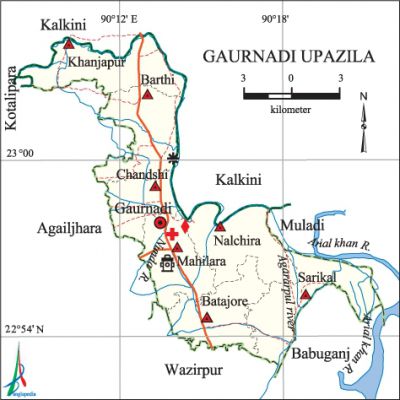Gaurnadi Upazila
Gaurnadi Upazila (barisal district) area 150.54 sq km, located in between 22°53' and 23°04' north latitudes and in between 90°08' and 90°22' east longitudes. It is bounded by kalkini upazila on the north, wazirpur upazila on the south, babuganj, muladi and Kalkini upazilas on the east, agailjhara and kotalipara upazilas on the west.
Population Total 188586; male 92209, female 96377; Muslim 158984, Hindu 27869, Buddhist 45, Christian 1684 and others 4.
Water bodies Main rivers: arial khan, Nunda, Agararpul.
Administration Gaurnadi Thana, now an upazila,' was established in 1806.
| Upazila | ||||||||
| Municipality | Union | Mouza | Village | Population | Density (per sq km) | Literacy rate (%) | ||
| Urban | Rural | Urban | Rural | |||||
| 1 | 7 | 108 | 109 | 42438 | 146148 | 1253 | 68.9 | 58.6 |
| Municipality | ||||||||
|
Area (acre) |
Ward |
Mahalla |
Population |
Density (per sq km) |
Literacy rate (%) | |||
| 16.83 | 9 | 20 | 42438 | 2522 | 68.9 | |||
| Union | ||||
| Name of union and GO code | Area (acre) | Population | Literacy rate (%) | |
| Male | Female | |||
| Khanjapur 55 | 5563 | 13057 | 13598 | 52.2 |
| Chandshi 38 | 1683 | 4760 | 5061 | 61.9 |
| Nalchira 71 | 5787 | 11123 | 12367 | 62.8 |
| Batajore 31 | 4982 | 10887 | 11143 | 63.9 |
| Barthi 23 | 4847 | 12713 | 13007 | 52.2 |
| Mahilara 63 | 3144 | 7331 | 7876 | 63.9 |
| Sarikal 94 | 6265 | 11133 | 12092 | 58.4 |
Source Bangladesh Population Census 2011,Bangladesh Bureau of Statistics.
Archaeological heritage and relics Allahr Masjid at Kasba.

War of Liberation The freedom fighters of the upazila raided the Gaurnadi Police Station on 9 October 1971. During the war of liberation the Pak army brutally killed many people at Trimohani and at a place on the back side of the Gaurnadi College; they also conducted devastating raids in the upazila. About 800 freedom fighters were killed in a number of encounters with the Pak army in different places of the upazila.
For details: see গৌরনদী উপজেলা, বাংলাদেশ মুক্তিযুদ্ধ জ্ঞানকোষ (Encyclopedia of Bangladesh War of Liberation), বাংলাদেশ এশিয়াটিক সোসাইটি, ঢাকা ২০২০, খণ্ড ৩।
Religious institutions Mosque 170, temple 205, church 6. Noted religious institutions: Allahr Masjid at Kasba.
Literacy rate and educational institutions Average literacy 60.9%; male 62.6%, female 59.3%. Noted educational institutions: Gaurnadi College (1964), Nalchira High School (1911), Barthi Tara Secondary school (1905), Gaurnadi Pilot Secondary School, Palarde Secondary School, Sarikal Secondary School, Tarki Bandar Victory Secondary School, Medhakul BNS Secondary School, Pinglakathi Model Govt. Primary School (1882), Harisen Government Primary School (1885), Ramsiddhi Bazar Government Primary School (1895), Batajore Ashwin Institute.
Cultural organisations Club 27, library 22, cinema hall 2, circus party, literary and cultural organisation 1. playground 13, theater party 2.
Newspapers and periodicals Gaurnadi.
Main sources of income Agriculture 51.59%, non-agricultural labourer 2.84%, industry 1.82%, commerce 18.93%, transport and communication 4.48%, service 9.75%, construction 2.32%, religious service 0.28%, rent and remittance 3.50% and others 4.49%.
Ownership of agricultural land Landowner 59.84%, landless 40.16%; agricultural landowner: urban 54.95% and rural 75.89%.
Main crops Paddy, wheat, potato, betel leaf, vegetables.
Extinct or nearly extinct crops Sesame, jute, mustard, kalai.
Main fruits Mango, jackfruit, banana, litchi, blackberry, palm, coconut, papaya.
Fisheries, dairies and poultries Poultry 35, dairy 12, Fishery 35, hatchery 4.
Communication facilities Pucca road 119 km, semi-pucca road 53 km, mud road 275 km; waterway 215 km.
Extinct or nearly extinct traditional transport Palanquin, dulki.
Noted manufactories Rice mill, flour mill, threshed rice mill, saw mill, welding factory, ice factory, bidi factory, bat factory.
Cottage industries Goldsmith, blacksmith, weaving, pottery, bamboo work.
Hats, bazars and fairs Hats and bazars are 23, fairs 8; most noted of which are Torki Hat, Kosba Hat, Mahilara Hat, Chandshi Kabiraj Bari Mela, Paus Sakranti Mela (Batajore) and Manasa Mela (Gaila).
Main exports Paddy, betel leaf, banana, curt.
Access to electricity All the unions of the upazila are under rural electrification net-work. However 57.4% of the dwelling households have access to electricity.
Sources of drinking water Tube-well 97.1%, tap 1.3% and others 1.6%.
Sanitation 86.0% of dwelling households of the upazila use sanitary latrines and 13.1% of dwelling houses use non-sanitary latrines; 0.9% of households do not have latrine facilities.
Health centres Upazila health complex 1, family planning centre 7, satellite health centre 4.
Natural disaster The cyclone and earth quake of 1737 and 1763 changed the course of the rivers of the region; it also changed the geological formations. Many settlements of the upazila were destroyed due to the cyclones and tidal bores of 1769, 1787, 1822, 1864 and 1876. Besides, the cyclones and tidal bores of 1776, 1882, 1909, 1919, 1941, 1958, 1961, 1965, 1970, 1988 and 1996 caused envy damages to settlements, crops and other properties of the upazila.
NGO activities Operationally important NGOs are brac, caritas, asa, proshika, CCDB. [Md Mizanur Rahman]
References Bangladesh Population Census 2001 and 2011, Bangladesh Bureau of Statistics; Cultural survey report of Gaurnadi Upazila 2007.
